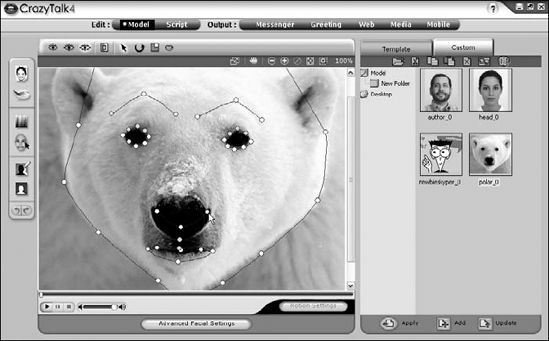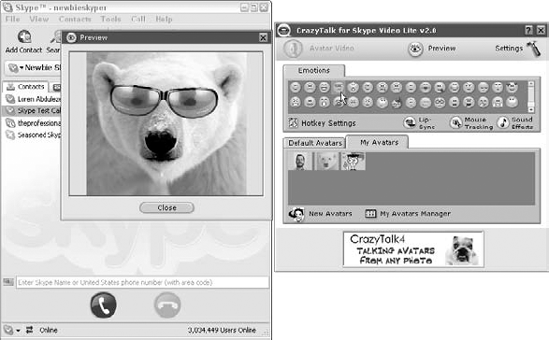Personalizing your profile with graphics
Creating avatars
We all like to make our mark, stand out in a crowd, and establish a unique identity. Broadcasting your personality to the world on Skype is not only fun but also may be a useful strategy if you use Skype as a business communication tool. Either way, you can find choices within the Skype program as well as third-party add-ons that allow you to strut your stuff. Personal choices include what logon name to choose, how much to say about yourself (covered in Chapter 2), and whether to post a photo, logo, or an avatar to show your face to the world? Decisions, decisions, decisions. It's up to you to make them, but it's up to this chapter to describe your choices and how to set them in motion.
If you don't select a photo or image, Skype automatically inserts a cartoon-like "ball headed" icon for you. If you don't have a photo or artwork, you can use one of the ready-to-use icons that Skype provides (see Figure 5-1). When you click the Change button in your profile, the My Pictures window appears.
These images are located in the My Skype Pictures directory of the My Documents folder.
If you are creating your own graphic, you can use JPG (.jpg) files or bitmap (.bmp) files. The ready-made images installed with the Skype software use PNG (.png) files, so PNG files are also acceptable.
When you use an image, Skype automatically scales your picture to fit inside a 96-x-96–pixel swatch.
Note
All the text content of your profile is stored in a centralized Skype database; however, your picture is kept only on your local computer. If you are using Skype both on a computer at work and at home, you need to keep your picture file on both. You also need to adjust your Skype profile on each machine so that the same picture appears.
Why limit yourself to a static picture if you don't have to? Skype allows you to create many ways to represent yourself visually. Among these are images called avatars.
The Hindu God Vishnu loved to change shape and appear in the form of a human or an animal. These forms are also called avatars. Because the personality is the same but the form is different, avatar became a handy word to describe images representing (and being controlled by) real people in a virtual environment.
However, computer avatars are not limited to human or animal forms. Some avatars are cartoon characters, robots, talking trees, teapots, smiley emoticons, and whatever your imagination can invent.
Skypers have taken avatar creation to a new level by making use of various avatar software tools. Your new Skype contact may come to you in the form of an image that moves, talks, expresses emotion, and generally reflects, in real time, what the "hidden" personality is saying and doing. You may find yourself talking to a little character that has been custom built to have green hair, violet eyes, a ten-gallon hat, and a golf club. (Sometimes our avatars say more about us than our real looks!) You may even see a dog talking while hearing your friend's voice in a Skype conversation.
Oddly, the avatar concept has come full circle. You not only can appear in the form of dog, cat, or coffee cup but also can take your own photograph — your real image — and turn that into a talking avatar. So, the real you takes on your own avatar form!
A very simple and inexpensive type of avatar you can create is called a WeeMee (see Figure 5-2).
When you click the Create My Avatar button, you are instantly whisked away to an avatar construction factory (see Figure 5-3).
You can try your hand at building a WeeMee by following these steps:
Click the Build Your WeeMee Now! button.
You are presented with a WeeMee without no features and holding a sign saying Male/Female.
Click the gender you want.
All the options for the WeeMee of that gender appear (see Figure 5-6). Depending on the options you select, you may have some animations in your avatar. For example, the boat and clouds of the WeeMee in Figure 5-4 are moving. (It's hard to make out in black and white here, but the boat is to the left, chugging down the waterway.)
You have a wide range of options for your WeeMee, including hair styles, fashions and interests. Keep exploring the offerings until you're done creating your WeeMee; then, click Save and Buy My WeeMee.
Are you ready to let your creative streak run free? Animated avatars that you can create with CrazyTalk Messenger take image interactivity to the next level. CrazyTalk comes in two versions: a free version called CrazyTalk for Skype (go to www.reallusion.com/crazytalk4skype) and a paid version called CrazyTalk Messenger (go to www.reallusion.com/crazytalk). The free version comes with a fixed selection of avatars that you can use but can't modify. CrazyTalk Messenger allows you to design and build avatars that you also can use in Skype. You can use photos of yourself. And by the way, having a photorealistic avatar of yourself on Skype may be the perfect solution for when you're having a bad hair day!
What do you want to make your animated avatar do? Maybe you want your character's mouth to lip-synch with yours as you speak on Skype, or perhaps you'd like it to capture a mood to suit the occasion.
Building avatars with CrazyTalk Messenger is surprisingly easy. We don't have the space here to step you through all the features of CrazyTalk, but we can tell you enough to whet your appetite. The first step is to import an image of the character you want to work with. The image can be a photo, a cartoon, or a scan of a portrait, for example. As long as it is a standard graphic such as a JPG file, that's fine. You can find some free and mostly copyright-friendly images at the following sites:
http://www.pics4learning.com http://www.freephotos.se http://en.wikipedia.org/wiki/Public_domain_image_resources
The best topics to search for are animals, portraits, and cartoons. Although you can find a wealth of images to choose from, be aware that some images may have copyright notices and usage restrictions.
To import a picture into CrazyTalk, follow these steps:
Click the top icon on the vertical toolbar on the left side of the Model Page.
The Open File window opens, enabling you to browse for image files on your hard drive. (Incidentally, CrazyTalk supports directly importing an image of a printed photo from a scanner attached to your computer.)
Navigate to the JPEG or BMP image file you want to import, click it, and then click the Open button.
There's more to animating an avatar than just importing a picture. When the avatar's jaws move in sync with your speech and its eyes blink, you want it to appear natural. You also need to draw some simple contour lines so that CrazyTalk knows how to smoothly morph the avatar's face when it is speaking or moving its head slightly.
After you import the picture, you can rotate the image so that the avatar's face is upright and vertical. If the face is slanted, the jaws can't move naturally. To fix the image, identify the spindle points for the lips and eyes (see Figure 5-5), as follows:
Click the Auto-Fit Anchor Points toolbar icon (the fourth icon in the vertical toolbar at the left).
The Auto-Fit Anchor Points window, shown in Figure 5-5, opens.
Drag the points over your imported image to match the reference image on the right; then, click the OK button.
CrazyTalk processes the image and generates a set of contour lines.
After the image is processed, you can adjust the main contour lines for the eyebrows, eyes, nose, mouth, and face mask (see Figure 5-6). CrazyTalk uses the position of these points to "morph" the picture to match your speech in Skype.
You can test your avatar by having it speak. Click the triangular Play button (see the bottom left of Figure 5-6) to start a prerecorded audio announcement. There are also pause, stop, and volume controls.
As you hear the message played, the avatar's mouth, eyes, and face move in sync with the audio message.
You can tweak the position of the spindle points and contour lines to get a fairly convincing animated avatar.
Click the Advanced Facial Settings button to access features that can help you deal with a variety of challenges. Say, for example, that you wanted to make the Mona Lisa into an avatar. Without some modification, you might find that making her image "speak" replaced that indelible smile with — gasp! — a need for dentures! Fortunately, CrazyTalk comes equipped with a set of virtual dentures (see Figure 5-7) and even a collection of eyes.

Figure 5.7. Smile! You can choose from a collection of virtual dentures of carnivores, pirates, and normal humans.
Some of the CrazyTalk facial settings include:
Adjustments to the eyes, teeth, and mouth: You can adjust the lighting levels inside the mouth, or even adjust ends of the lips to give the appearance of a smile or a frown.
Head motion: You can set the head motion to match the energy of your character.
Facial formatting: A nice finishing touch of this software is that you can have the mouth automatically close when the avatar stops speaking.
CrazyTalk Messenger makes it easy to create, test, and customize your avatar. After the avatar is created with Messenger, you can run it in Skype using another software product, CrazyTalk for Skype Video Lite, which is available as a free download (go to https://share.skype.com/directory/crazytalk_for_skype_video_lite/view and click the Download Now link).
The Video Lite program connects your CrazyTalk avatar to Skype. CrazyTalk uses the video channel in Skype to broadcast your avatar as though you had a webcam.
To enliven your avatar, you can use a behavior panel with special kinds of emotion smileys (see Figure 5-8). Despite the term smiley, you can click these images to show your avatar laughing, crying, frowning, and looking surprised, among other expressions.
During the course of a Skype conversation, you can nimbly switch from one kind of avatar to another by choosing the My Avatars or Default Avatars tab and clicking the image of the avatar you want shown.
Aside from choosing a phone color or style, making a ring louder or softer, or changing a message, personalizing electronic communications has been rather limited until recently. Skype conversations, however, can take many forms at the same time: voice, image, text, and video. Within each of these forms, you have many opportunities to make a unique statement and project your personal style. If you are an artist, you might choose an avatar for yourself as an abstract painting. If you are a businessman, your image can be your company logo. Your choice of personalization can associate you with what you think is important, and you can change your image to reflect a mood, point of view, or occupation whenever you want. The best part is that the choice is yours.
Beyond actively projecting an image or avatar, you can also personalize your Skype environment in the background by adding, or omitting, information in your profile. If you are in business and want a high-profile presence on Skype, the more you put in a profile, the better. If you are the quiet type, you can skimp on the information you put in without taking yourself completely out of the search loop. Personalizing your mode of communication is more than decorating; it's a powerful way to tell the world who you are.








